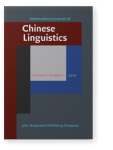Vol. 6:1 (2019) ► pp.119–161
The phonological word in the Ningbo dialect
This paper examines the domain of the prosodic word in the Ningbo dialect. The goal of this paper is to provide a critical review of the studies on the prosodic word (PW) in various languages of the world, and to investigate the phonological phenomena within the domain formed by morpho-syntactic words in the Ningbo dialect as well as discussing the role that the prosodic word plays in the phonological rule application in the Ningbo dialect.
This paper provides a complete survey on various types of morpho-syntactic formation in the Ningbo dialect as well as examining the application of phonological phenomena with reference to the different types of morpho-syntactic words. It will show that the lexical tone sandhi rule (LTS) applies within the domain formed by the major types of morpho-syntactic words in Ningbo dialect. However, pure phonological information may also affect the application of LTS.
Article outline
- 1.Introduction
- 1.1Definition of the prosodic word
- 1.2The prosodic word domain
- 2.Diagnostics for the prosodic word
- 3.Morphosyntactic words in the Ningbo dialect
- 3.1Monomorphemic words
- 3.2Derived words
- 3.2.1Prefix 阿‑ [aʔ]
- 3.2.2Prefix 老‑ [lɐu]
- 3.2.3Suffix -头 [dəʏ]
- 3.2.4Suffix -子 [tsɿ]
- 3.2.5Suffix -刮气 [kuaʔ hi]
- 3.2.6Infix -打‑ [tã]
- 3.2.7Infix -刮‑ [kuaʔ] or -刮斯‑ [kuaʔ sɿ]
- 3.2.8Infix -得斯‑ [taʔ sɿ]
- 3.2.9Derived words containing more than one affixes
- 3.3Compounds
- 3.3.1Subject-verb compounds
- 3.3.2Verb-object compounds
- 3.3.3Adverbial modifier-head and adnominal modifier-head compounds
- 3.3.4Coordination compounds
- 3.3.5Verb-complement compounds
- 3.4Reduplication
- 3.4.1Reduplicated nouns
- 3.4.2Reduplicated adjectives
- 3.4.3Reduplicated verbs
- 3.5Summary
- 4.Phonological rule application in the phonological word domain in the Ningbo dialect
- 4.1Application of phonological tone sandhi
- 4.1.1Application of LTS in monomorphemic words, derived words and compound words
- 4.1.2Application of LTS in reduplicated nouns, adjectives, verbs, or quantifiers
- 4.1.5Summary
- 4.2Diminutive tone sandhi
- 4.2.1Diminutive nouns and diminutive tone sandhi
- 4.2.2Diminutive adjectives and verbs
- 4.2.3LTS vs. DTS in the Ningbo dialect
- 4.3Lexical diffusion in the Ningbo dialect
- 4.4TS within longer polysyllabic words
- 4.4.1Rhythm effect in the TS for monomorphemic words
- 4.4.2Re-division of domain within longer compounds
- 4.4.3Minimal and Maximal Requirements
- 4.1Application of phonological tone sandhi
- 5.Conclusion
-
References
